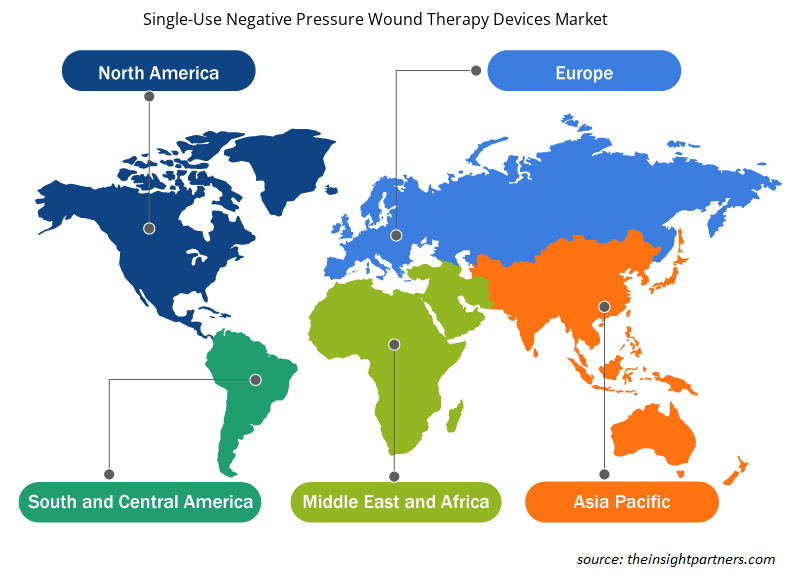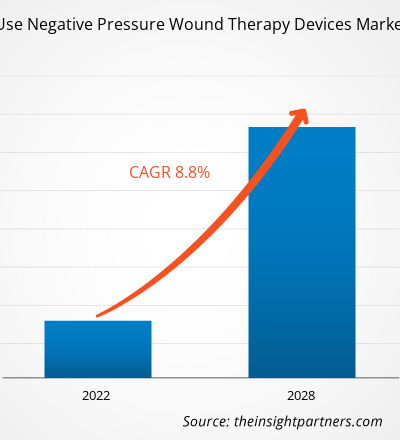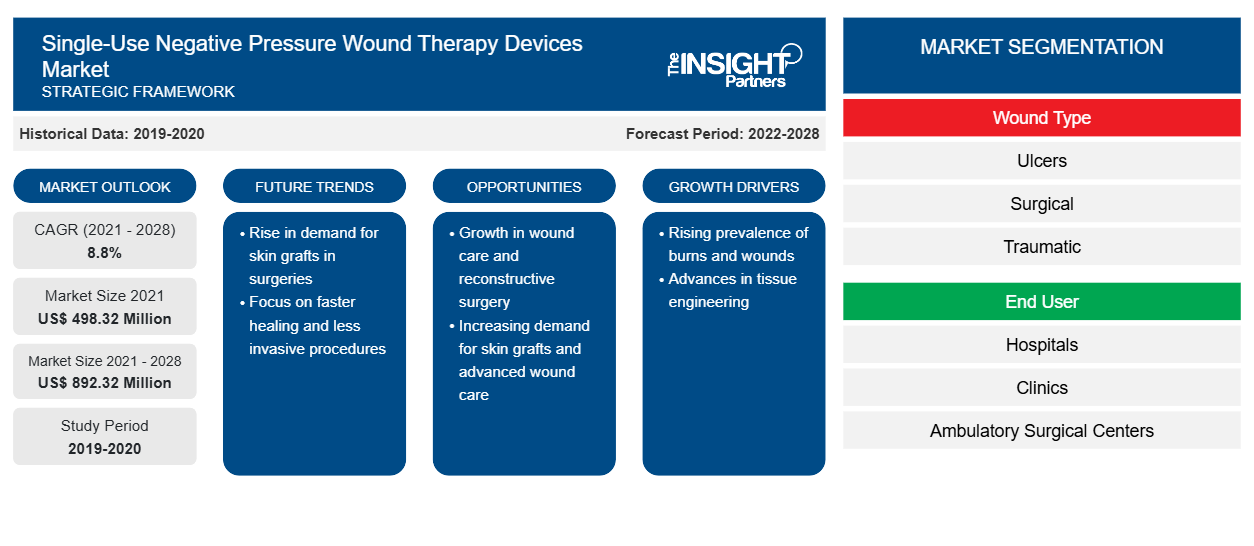Der Markt für Einweggeräte zur Unterdruck-Wundtherapie soll von 498,32 Millionen US-Dollar im Jahr 2021 auf 892,32 Millionen US-Dollar im Jahr 2028 anwachsen; für den Zeitraum von 2021 bis 2028 wird eine durchschnittliche jährliche Wachstumsrate (CAGR) von 8,8 % erwartet.
Die Unterdruck-Wundtherapie ( NPWT ) wird zur Behandlung einer Vielzahl von Wundtypen eingesetzt, darunter traumatische, schwer heilende und chronische Wunden. Sie wird auch zur Behandlung von Wunden eingesetzt, die mit Lappen oder Hauttransplantaten abgedeckt sind. Diese Therapie wird in ein medizinisches Gerät wie ein Einweg- NPWT -Gerät umgesetzt, ein kleines batteriebetriebenes Gerät im Taschenformat. Wie der Name schon sagt, handelt es sich dabei um tragbare Einweggeräte, die im Allgemeinen für die ambulante Behandlung verwendet werden.
Der Bericht bietet Einblicke und eine eingehende Analyse des Marktes für Einweg-Unterdruck-Wundtherapiegeräte und legt dabei den Schwerpunkt auf verschiedene Parameter wie Markttrends, technologische Fortschritte, Marktdynamik und Wettbewerbslandschaftsanalysen führender Marktteilnehmer auf der ganzen Welt. Er umfasst auch die Auswirkungen der COVID-19-Pandemie auf den Markt in allen Regionen. Der Markt für Einweg-Unterdruck-Wundtherapiegeräte verzeichnete zu Beginn der COVID-19-Krise einen Engpass aufgrund von Störungen in der Lieferkette und einen Nachfrageeinbruch aufgrund der von den meisten Ländern weltweit angekündigten Ausgangssperre , die zu Störungen in der Produktion und im Betrieb des Pharmasektors führte. Darüber hinaus sind die Dienstleistungen für die Versorgung chronischer Wunden im ersten und zweiten Quartal 2020 drastisch zurückgegangen, haben sich jedoch Ende 2020 normalisiert. Darüber hinaus bevorzugen die Menschen Einweggeräte, um Kreuzkontaminationen durch Geräte zu reduzieren. Die zunehmende Verwendung von Einweg- NPWT- Geräten (Einmalgebrauch) treibt deren Nachfrage auf dem globalen Markt für Einweg-Unterdruck-Wundtherapiegeräte an. Darüber hinaus gab es einen deutlichen Rückgang der stationären und ambulanten Patienten bei privaten Krankenhausketten. Um die Gesundheitssysteme zu entlasten, haben viele Kliniken Diagnosen und Behandlungen außer bei COVID-19 verschoben. In Indien beispielsweise wurde das staatliche Victoria Hospital, das dem Bangalore Medical College and Research Institute ( BMCRI ) angeschlossen ist, in eine spezielle COVID-19-Einrichtung umgewandelt, seit die Pandemie im März Karnataka erreichte . Der Betrieb der Mahabodhi Burns Ward im Krankenhaus wurde davon nicht beeinträchtigt. Trotz der Pandemie setzte das Krankenhaus seinen normalen Betrieb unter Einhaltung aller COVID-19-Vorsichtsmaßnahmen fort.
Passen Sie diesen Bericht Ihren Anforderungen an
Sie erhalten kostenlose Anpassungen an jedem Bericht, einschließlich Teilen dieses Berichts oder einer Analyse auf Länderebene, eines Excel-Datenpakets sowie tolle Angebote und Rabatte für Start-ups und Universitäten.
-
Holen Sie sich die wichtigsten Markttrends aus diesem Bericht.Dieses KOSTENLOSE Beispiel umfasst eine Datenanalyse von Markttrends bis hin zu Schätzungen und Prognosen.
Die Behandlung chronischer Wunden während der Pandemie war für beide Seiten – Patienten und Ärzte – eine sehr schwierige Aufgabe. Um das Expositionsrisiko während der Pandemie zu minimieren, verwendeten die Patienten Einweggeräte anstelle herkömmlicher NPWT- Geräte. Aus gesundheitlichen Gründen bevorzugten die Menschen Einwegprodukte zur Behandlung chronischer und akuter Wunden. Dieser Faktor unterstützte das Wachstum des Marktes während der Pandemie. Der Markt für Einweggeräte zur Unterdruck-Wundtherapie ist nach Wundtyp, Endverbraucher und Geografie segmentiert. Der Markt ist nach Regionen in Nordamerika, Europa, Asien-Pazifik, den Nahen Osten und Afrika sowie Süd- und Mittelamerika unterteilt.
Markteinblicke
Zunahme bei Verbrennungsfällen
Im Jahr 2019 wurden weltweit insgesamt 8.378.122 neue Fälle von Verbrennungen festgestellt. In vielen Ländern mit hohem Einkommen ist die Sterberate durch Verbrennungen rückläufig, doch in Ländern mit niedrigem und mittlerem Einkommen liegt die Sterberate von Kindern durch Verbrennungen inzwischen etwa siebenmal höher als in Ländern mit hohem Einkommen. Das Unterdruck-Wundtherapiesystem zum Einmalgebrauch wird zur Behandlung akuter und chronischer Wunden sowie geschlossener chirurgischer Schnitte mit geringer bis mäßiger Exsudatmenge verwendet . Bei der Unterdruck-Wundtherapie ( NPWT ) wird Unterdruck (Vakuum) auf eine Wunde ausgeübt, um sie zu versorgen und die Heilung zu fördern. Weitere Bezeichnungen für NPWT sind topische Unterdrucktherapie ( TNP ), vakuumgestützter Wundverschluss (VAC) und versiegelte Wundabsaugung an der Oberfläche . Die NPWT wird verwendet, um bei Brandverletzten überschüssige Flüssigkeit abzulassen und die lokale Durchblutung zu verbessern. Es wird vermutet, dass die Wirkung der NPWT zu einer erhöhten Sauerstoff- und Nährstoffzufuhr zur Verbrennung führen und so die Heilung fördern kann. Das Einmal-Unterdruck-Wundtherapiesystem ist für Personen gedacht, die von einem Absauggerät (Unterdruck-Wundtherapie) profitieren würden, da es die Wundheilung fördert, indem es geringe bis mittlere Mengen Exsudat und infektiöse Rückstände entfernt. Beispiele für akzeptable Wundtypen sind chronische, akute, traumatische, subakute und klaffende Wunden, Verbrennungen zweiten Grades, Geschwüre (z. B. diabetische oder Druckgeschwüre), Lappen und Transplantate sowie geschlossene chirurgische Schnitte.
Darüber hinaus werden nach Angaben des Children's Burn Trust und der British Burn Association jeden Monat 625 Kinder wegen Verbrennungen oder Verbrühungen in die Verbrennungsstation des NHS eingeliefert. Im Jahr 2017 behandelten die Verbrennungs- und Verbrühungsstationen des NHS über 15.000 Patienten mit derartigen Verletzungen, wobei Gesamtkosten von über 24,94 Millionen US-Dollar ( d. h . 20 Millionen GBP ) entstanden. Über 40 aller Verbrennungsbehandlungen im Jahr 2017 wurden als extrem schwerwiegend eingestuft, wobei die Behandlungskosten über 118.455,50 US-Dollar ( 95.000 GBP ) pro Person betrugen. In Entwicklungsregionen wie dem Asien-Pazifik-Raum, Afrika und dem Nahen Osten nehmen Verbrennungen durch Haushalts- und Industrieunfälle zu. Der Markt für Einweg-Wundpflegegeräte mit Unterdruck wird daher durch die steigende Zahl von Verbrennungen und ähnlichen Verletzungen angetrieben.
Erkenntnisse basierend auf Wundtypen
Der globale Markt für Einweg-Unterdruck-Wundtherapiegeräte wurde nach Wundtyp in Geschwüre, chirurgische Wunden, traumatische Wunden, Sportverletzungen, Lappen und Transplantate sowie Verbrennungen unterteilt. Im Jahr 2022 hatte das traumatische Segment den größten Marktanteil; es wird erwartet, dass es seine Dominanz im Prognosezeitraum beibehält. Diese Art von Wunde ist aufgrund der zunehmenden Häufigkeit von Verkehrsunfällen und Traumafällen am häufigsten. Darüber hinaus wird erwartet, dass das traumatische Segment im Zeitraum 2021–2028 die höchste durchschnittliche jährliche Wachstumsrate verzeichnet.
Endbenutzerbasierte Erkenntnisse
Basierend auf dem Endverbraucher wurde der Markt für Einweg-Unterdruck-Wundtherapiegeräte in Krankenhäuser, Kliniken, ambulante chirurgische Zentren und andere unterteilt. Das Krankenhaussegment hielt im Jahr 2022 den größten Marktanteil und wird im Prognosezeitraum voraussichtlich die höchste durchschnittliche jährliche Wachstumsrate verzeichnen.
Die Marktteilnehmer für Einweggeräte zur Unterdruck-Wundtherapie verfolgen organische Strategien wie Produkteinführung und -erweiterung, um ihre Präsenz und ihr Produktportfolio weltweit zu erweitern und die steigende Nachfrage zu decken.
Geographiebasierte Erkenntnisse
Geografisch ist der Markt für Einweggeräte zur Unterdruck-Wundtherapie segmentiert in Nordamerika (USA, Kanada und Mexiko), Europa (Frankreich, Deutschland, Großbritannien, Spanien, Italien und das übrige Europa), Asien-Pazifik (China, Indien, Japan, Australien, Südkorea und der restliche Asien-Pazifik-Raum ), Naher Osten und Afrika (Saudi-Arabien, die Vereinigten Arabischen Emirate , Südafrika und der restliche Nahe Osten und Afrika ) sowie Süd- und Mittelamerika (Brasilien, Argentinien und der restliche Süd- und Mittelamerika).
Regionale Einblicke in den Markt für Einweg-Unterdruck-Wundtherapiegeräte
Die regionalen Trends und Faktoren, die den Markt für Einweg-Unterdruck-Wundtherapiegeräte während des gesamten Prognosezeitraums beeinflussen, wurden von den Analysten von Insight Partners ausführlich erläutert. In diesem Abschnitt werden auch die Marktsegmente und die Geografie von Einweg-Unterdruck-Wundtherapiegeräten in Nordamerika, Europa, im asiatisch-pazifischen Raum, im Nahen Osten und Afrika sowie in Süd- und Mittelamerika erörtert.

- Erhalten Sie regionale Daten zum Markt für Einweg-Unterdruck-Wundtherapiegeräte
Umfang des Marktberichts zu Geräten zur Einmal-Unterdruck-Wundtherapie
| Berichtsattribut | Details |
|---|---|
| Marktgröße im Jahr 2021 | 498,32 Millionen US-Dollar |
| Marktgröße bis 2028 | 892,32 Millionen US-Dollar |
| Globale CAGR (2021 - 2028) | 8,8 % |
| Historische Daten | 2019-2020 |
| Prognosezeitraum | 2022–2028 |
| Abgedeckte Segmente |
Nach Wundtyp
|
| Abgedeckte Regionen und Länder |
Nordamerika
|
| Marktführer und wichtige Unternehmensprofile |
|
Marktteilnehmerdichte bei Einweg-Unterdruck-Wundtherapiegeräten: Auswirkungen auf die Geschäftsdynamik verstehen
Der Markt für Einweg-Unterdruck-Wundtherapiegeräte wächst rasant, angetrieben von der steigenden Nachfrage der Endnutzer aufgrund von Faktoren wie sich entwickelnden Verbraucherpräferenzen, technologischen Fortschritten und einem größeren Bewusstsein für die Vorteile des Produkts. Mit steigender Nachfrage erweitern Unternehmen ihr Angebot, entwickeln Innovationen, um die Bedürfnisse der Verbraucher zu erfüllen, und nutzen neue Trends, was das Marktwachstum weiter ankurbelt.
Die Marktteilnehmerdichte bezieht sich auf die Verteilung der Firmen oder Unternehmen, die in einem bestimmten Markt oder einer bestimmten Branche tätig sind. Sie gibt an, wie viele Wettbewerber (Marktteilnehmer) in einem bestimmten Marktraum im Verhältnis zu seiner Größe oder seinem gesamten Marktwert präsent sind.
Die wichtigsten Unternehmen auf dem Markt für Einweg-Unterdruck-Wundtherapiegeräte sind:
- Cardinal Health Inc
- ConvaTec Group Plc
- Carilex Medizin
- Genadyne Biotechnologies, Inc.
- H und R Gesundheitswesen
Haftungsausschluss : Die oben aufgeführten Unternehmen sind nicht in einer bestimmten Reihenfolge aufgeführt.

- Überblick über die wichtigsten Akteure auf dem Markt für Einweg-Unterdruck-Wundtherapiegeräte
Unternehmensbasierte Einblicke
Cardinal Health Inc; ConvaTec Group Plc; Carilex Medical; Genadyne Biotechnologies, Inc.; H and R Healthcare; Lohmann & Rauscher GmbH & Co. KG; Medela AG; Mölnlycke Health Care AB; Paul Hartmann Ag; und Smith & Nephew plc gehören zu den führenden Unternehmen auf dem Markt für Einweggeräte zur Unterdruck-Wundtherapie.
- Historische Analyse (2 Jahre), Basisjahr, Prognose (7 Jahre) mit CAGR
- PEST- und SWOT-Analyse
- Marktgröße Wert/Volumen – Global, Regional, Land
- Branchen- und Wettbewerbslandschaft
- Excel-Datensatz
Aktuelle Berichte
Erfahrungsberichte
Grund zum Kauf
- Fundierte Entscheidungsfindung
- Marktdynamik verstehen
- Wettbewerbsanalyse
- Kundeneinblicke
- Marktprognosen
- Risikominimierung
- Strategische Planung
- Investitionsbegründung
- Identifizierung neuer Märkte
- Verbesserung von Marketingstrategien
- Steigerung der Betriebseffizienz
- Anpassung an regulatorische Trends























 Kostenlose Probe anfordern für - Markt für Einweg-Unterdruck-Wundtherapiegeräte
Kostenlose Probe anfordern für - Markt für Einweg-Unterdruck-Wundtherapiegeräte